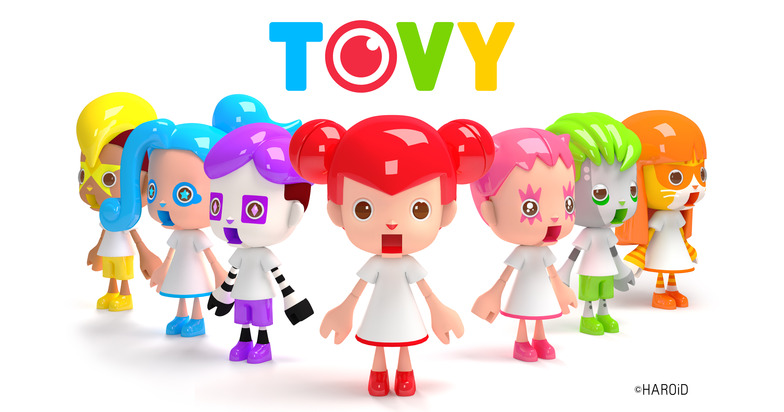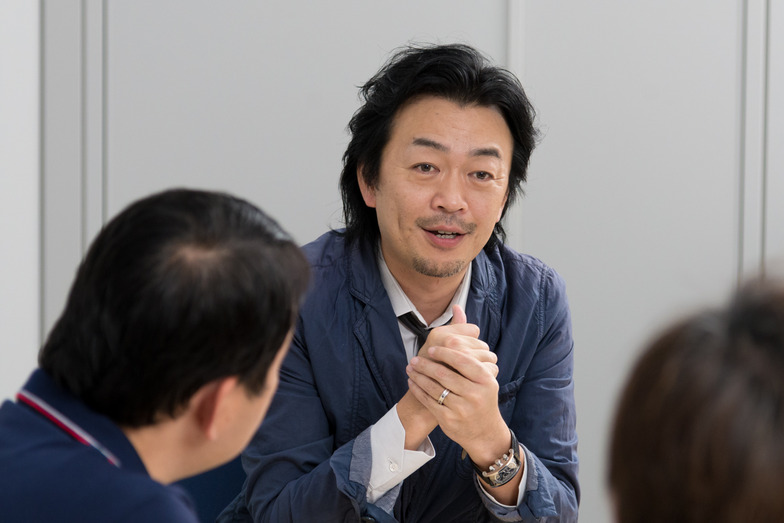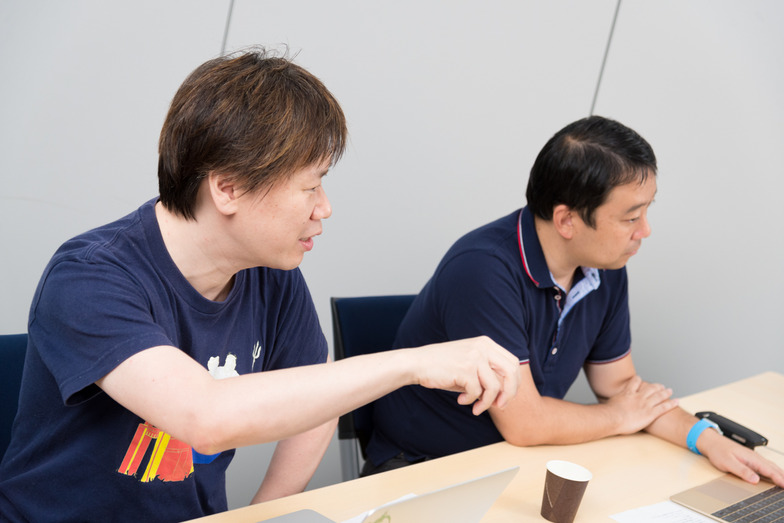Following the first part, we spoke with Mr
. Kiyotaka Ando,
President and CEO of
HAROiD; Mr. Masayoshi Park,
Representative of Bascule and CCO of HAROiD; and Mr. Hideaki Haruta, involved in business development at Dentsu Inc., about
the future of television and the integration of the internet and television that
HAROiD aims for. We also hear about the new services HAROiD is developing.
Your partner appears inside the TV. The "TOVY" Project
Haruta: In the second part, I'd like to hear specifically about the exciting things HAROiD is planning for the future. Could you tell us a bit about the projects currently in progress?
Ando: We're considering letting viewers create avatar-like digital characters and have them appear on TV. You'd create your own alter ego character on your smartphone and have it appear on the TV screen. This character could be the basis for all sorts of new developments.
When we started JoinTV, we thought about how to get viewers involved in the program. We also wanted to create a system that clearly showed how they were participating, not just as one vote among tens of thousands.
For example, we experimented with ideas like linking to Facebook and displaying the viewer's face or their friends' faces on TV. It was certainly interesting, but on the other hand, only a small handful with strong self-display desires might actually want their face shown. I felt there might be a different form of program participation.

Another challenge I wanted to solve was this: even for a TV program watched by many people nationwide, the moment you turn on the TV, you have no idea if a large crowd is watching it with you. I believe it's crucial to feel that many people are watching together, sharing emotions and excitement. For that, we needed a system beyond just live-stream comments or tweets – something that lets you express yourself and feel more integrated with the TV experience.
To solve these two challenges, we decided to launch "TOVY." It's "TOVY" from "Toy" and "TV."
Park: TOVY is a symbol connecting television and the internet—in other words, a symbol connecting mass media and personal media in the public sphere.
When we thought about creating something that could move between both worlds, we wanted something symbolic—after all, television is such a wonderful world of entertainment.
That's why, partly playing on the name HAROiD, I wondered if we could create something like a personal android. Not just an avatar that looks like you, but more like giving your android partner TOVY a command like, "Go check out the TV world for a bit."
I'm also thinking about a system where TOVY stores energy from my daily activities online and in the real world. If I use that energy effectively, TOVY could make a noticeable impact in the TV world. It sounds fun and something everyone could get excited about, right?

TOVY Creation Page ( From HAROiD Press Release ©NTV)

TOVY Program Appearance Image ( From HAROiD Press Release ©NTV)
Of course, I don't think every TV program should be like this. But don't you think it's okay for such a genre to emerge? Using TV as a stage where everyone connects and enjoys together. I hope TOVY can play a role that further enhances TV's original aspect of providing topics for communication.
Some might say existing SNS account icons would suffice instead of TOVY, but many are legally restricted, making them difficult to use on TV. That's why we decided to create our own. Since we were building it anyway, we chose to develop a 3D character with an eye toward the future. HAROiD is a company that makes TV and the internet more enjoyable. In the near future, we want to create something that becomes a symbol of new enjoyment, like a program where viewers' TOVYs embark on an adventure journey.
Haruta: This sounds like a groundbreaking service that could transform the relationship between viewers and TV programs. Above all, it looks incredibly fun—I'm already excited!
Alongside Nippon TV, Basquiat, and Dentsu Inc., BeMap—which bridges infrastructure using digital technology—is also collaborating with HAROiD. What do you expect from BeMap, which excels in service planning, development, and operation?
Ando: BeMap is quite an unconventional company, isn't it? They're fundamentally an infrastructure company handling solid, technical work, yet they also absolutely love projects involving TV and content.
Fundamentally, BeMap excels at building infrastructure and mechanisms in physical spaces—like constructing Wi-Fi networks, developing convenience store payment systems, creating transit solutions like transfer guides, and handling TV metadata. The limitation of TV is that while it broadcasts to raise awareness and spark interest, it gradually becomes disconnected from the real-world action needed to drive people to take steps in physical locations. It even feels out of reach when it comes to driving action in real spaces. That's where BeMap comes in. This falls under the O2O2O (On-Air to Online to Offline) domain. We anticipate a chemical reaction occurring when HAROiD's content and systems connect to real-world spaces like storefronts, transportation hubs along daily routes, and events.
Haruta: So the goal is to provide mechanisms and devices that stimulate consumer behavior—moving from TV to digital, and then further into real-world spaces like stores and commutes.
Leaving Nippon TV to invent new culture
Haruta: HAROiD originated from Nippon TV's "JoinTV." In that regard, what is the relationship between HAROiD and Nippon TV?
Ando: At JoinTV, I was working as a Nippon TV employee, creating content for Nippon TV. However, looking at Nippon TV's programming schedule, there were things we couldn't do. I felt we were far from achieving the "invention of new culture" I mentioned earlier, so we made it an independent company called HAROiD.
This allows us to work not only with key and quasi-key stations, but also with local stations, BS, and CS channels. Depending on the situation, we can also partner with video streaming sites or real-world events to try new things. In fact, our know-how, tools, and systems should be useful in those areas too.
Eventually, we're looking beyond Japan to the world. We envision global events where everyone participates simultaneously, using TV
It would be interesting to share something on the same screen across TVs and smartphones. We want to partner with various entities and create new inventions.
Park: At HAROiD, our motto is "Let's tone down the Nippon TV color." There might be a misconception that we only handle Nippon TV content, but we really want other stations to utilize us too.
You might think, "Participatory programs must be expensive," but we do it cheaply, quickly, and well (laughs), so we'd like you to try it, including trial runs. In that sense, we truly hope that Dentsu Inc. will help bridge the gap.
What HAROiD will offer going forward, and the television we envision for 2030
Haruta: Speaking with both of you, I sensed a mindset that as the relationship between the internet and television changes, "we shouldn't just react to change, but instead proactively drive change ourselves." Finally, could you tell us what kind of television future HAROiD wants to create, looking toward 2020 and then 2030?
Ando: By 2020 or 2030, things beyond our imagination will likely be happening. Everyone uses smartphones now, but the iPhone debuted just eight years ago. Yet it transformed media so drastically. So looking toward 2030, I think we need to deliberately envision things we can't even imagine and work toward them.
In that sense, the Internet of Things (IoT) is a key keyword. You know, that thing where all sorts of objects—like watches and house keys—are constantly connected to the internet. The era where television, the medium with the greatest reach, is always connected to the internet is coming soon.
Here's an interesting story: I once had the chance to speak with someone responsible for smart TVs at an appliance manufacturer. When they showed me a prototype, I asked, "What happens if this isn't connected to the internet?" They looked at me like I was crazy and replied, "If it's not connected to the internet, it's just a TV."
At the time, I thought, "Well, a regular TV is fine, isn't it?" But upon reflection, if a smartphone wasn't connected to the internet, it would just be a phone, right? The point is, TVs will eventually become that kind of thing.

I believe that going forward, it will be a fundamental assumption that not just TVs, but all kinds of things will be connected to the internet. Right now, we talk about the convergence of broadcasting and communications, or TV and the internet. But once connectivity becomes the baseline, I think it will be crucial to leverage all kinds of data—like user actions—based on the device's characteristics and the user themselves, to develop services that feel good for the user.
Considering TV's characteristics: it's not always physically close to you, and input comes via the remote. Basically, you turn it on, change channels, and programs switch. In other words, it's a device with minimal input and high output. Given these traits, TV might evolve into a device that, when you turn it on after coming home, outputs optimized information tailored to whoever is in front of it—you, your family, or whoever is present. If that happens, once you turn it on, you probably won't need to touch the remote again.
In a way, it's a return to the traditional role of mass media delivering information. However, through IoT, the fusion of mass and personal, or mass and home/family, enables the delivery of more segmented, personalized information. HAROiD envisions progressing toward achieving what's necessary for this future.
Haruta: What about you, Mr. Park?
Park: I also fundamentally believe TVs will be connected to the internet as a given. Like Mr. Ando said, just as few people use smartphones only for calls, TVs won't just show broadcasts anymore. For me, that's exciting, and I want to create something everyone can enjoy in this new era.
It might not be content per se, but rather an event, like what we discussed earlier. Take Koshien, for example—it generates huge excitement. Koshien as an event has spawned various content like manga and movies. I want to create a new nationwide event centered around smart TVs, something everyone can lean forward and participate in. It could be a quiz show where everyone joins in, or a gourmet program where we all eat together.
I suspect such attempts would struggle to succeed if initiated by internet companies that primarily offer services tied to individual users. Conversely, television creators possess an incredible creative skill—they can make viewers emotionally invested in things seemingly unrelated to themselves. Take the 100km marathon on 24-Hour TV, for instance. To put it bluntly, it's just celebrities running, right? (laughs) Yet television professionals elevate it into a national event.
Looking ahead to the era of smart TVs, I'd be thrilled if HAROiD could become a team that keeps trying to create unprecedented new events. A team that can skillfully combine this sense of personal connection with the ability to craft stories that move everyone. We're actively seeking people to take on this challenge with us!
Haruta: HAROiD challenges itself to create new value for television across various fields—whether it's logging into TV to broaden how viewers enjoy programs, creating "simultaneous experience value" that digitally extends TV's reach, or connecting actions triggered by content viewing to real-world settings. With HAROiD's arrival, the relationship between TV and the internet will change, and new advertising and marketing methods optimized for this will surely emerge. We expect to share various concrete details soon, so please look forward to them. Mr. Ando, Mr. Park, thank you for your valuable insights today.
For the latest HAROiD initiatives and releases, please visit:
http://www.haroid.co.jp/
http://www.haroid.co.jp/img/20151116.pdf












